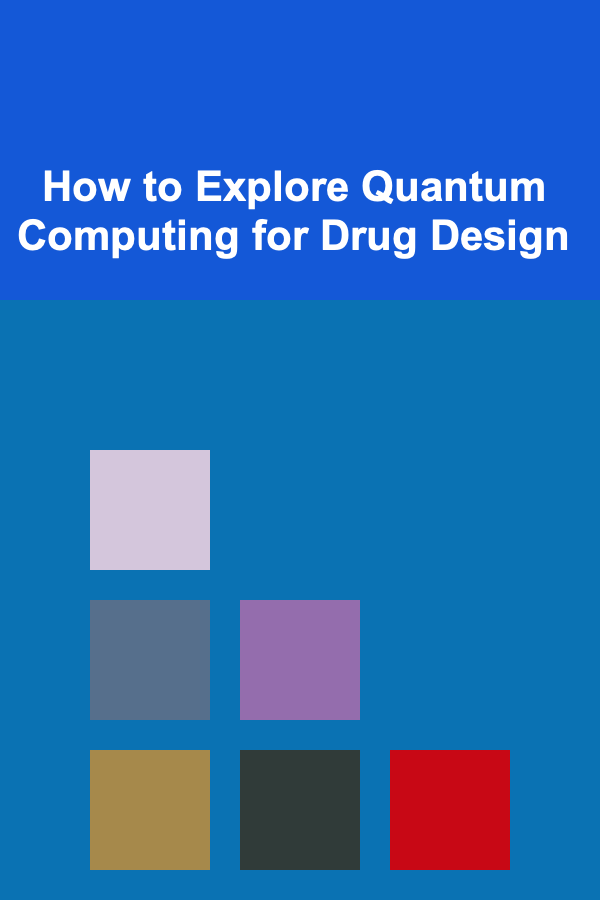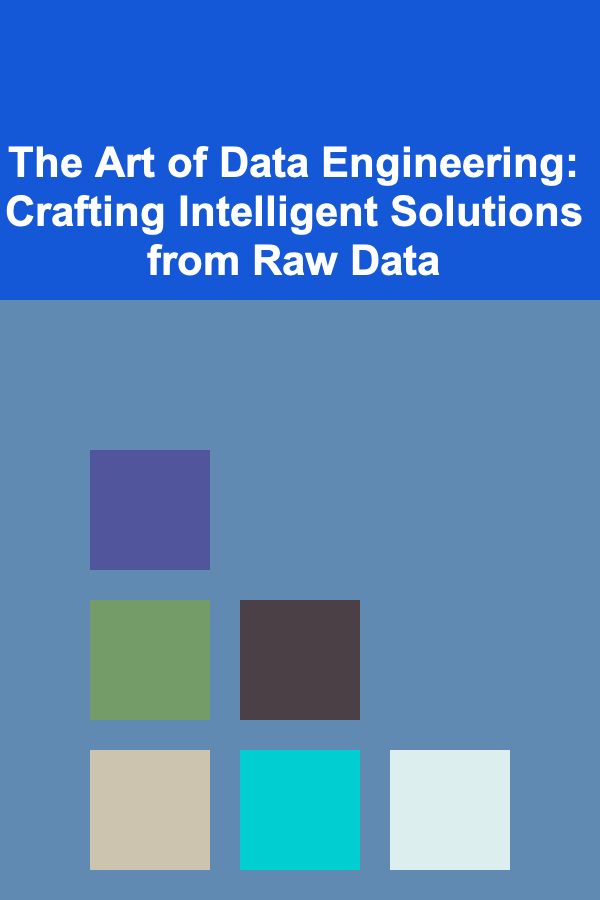
How to Explore Quantum Computing for Drug Design
ebook include PDF & Audio bundle (Micro Guide)
$12.99$7.99
Limited Time Offer! Order within the next:

Quantum computing is on the verge of revolutionizing many fields, and one of its most exciting applications lies in the realm of drug design. Traditional drug discovery methods can take years, with a substantial amount of trial and error involved. The advent of quantum computing has the potential to dramatically speed up the process, making drug design more efficient, cost-effective, and precise. This article delves deep into the role of quantum computing in drug design, the current state of this field, its potential advantages, challenges, and future prospects.
Introduction to Quantum Computing
Before we dive into its application in drug design, it's essential to understand what quantum computing is and how it differs from classical computing. Classical computers, which we use every day, process information in binary form, using bits that are either 0 or 1. These bits are manipulated through a series of logical operations to perform computations.
Quantum computing, on the other hand, uses quantum bits, or qubits. Unlike classical bits, qubits can represent both 0 and 1 simultaneously, thanks to a property known as superposition. Moreover, qubits can be entangled, meaning the state of one qubit can depend on the state of another, regardless of the distance between them. This enables quantum computers to perform complex calculations that classical computers struggle with.
The potential power of quantum computing lies in its ability to solve certain types of problems exponentially faster than classical computers. This is particularly valuable in fields like drug design, where simulations of molecular interactions can require immense computational resources.
The Need for Quantum Computing in Drug Design
Drug discovery and design are inherently complex processes that involve simulating and analyzing the interactions of billions of molecules to identify potential drug candidates. Traditionally, this process is carried out using classical computational methods like molecular docking, molecular dynamics simulations, and virtual screening. However, these methods are computationally expensive and limited in their ability to simulate the behavior of molecules at a quantum level.
Quantum computing offers a solution to these limitations by enabling simulations that can account for the full quantum mechanical behavior of molecules. This means that quantum computers could potentially model molecular interactions with unprecedented accuracy, leading to faster identification of viable drug candidates, better understanding of molecular mechanisms, and more effective therapies.
Current Drug Discovery Process
The traditional drug discovery process typically follows several key stages:
- Target Identification and Validation: Identifying and validating the biological target (often a protein) that a drug will interact with.
- Lead Discovery: Finding molecules that can interact with the target, often using high-throughput screening of large chemical libraries.
- Lead Optimization: Refining these molecules to improve their effectiveness, stability, and selectivity.
- Preclinical and Clinical Trials: Testing the lead compound in vitro (in a laboratory setting) and in vivo (in animals and humans).
Each of these stages involves significant computational work, such as simulating molecular interactions, predicting the behavior of potential drug molecules, and analyzing complex data. Quantum computing can enhance this process by providing more accurate models and speeding up simulations, especially in the early stages of drug discovery.
Quantum Computing and Drug Design: Potential Applications
Quantum computing holds immense potential to transform the drug discovery process. Below are several ways in which quantum computing could play a role in drug design.
1. Quantum Simulation of Molecules
One of the most significant applications of quantum computing in drug design is the simulation of molecular interactions at a quantum level. Classical computers struggle to simulate the behavior of molecules accurately because the number of possible configurations increases exponentially with the size of the molecule. Quantum computers, however, can naturally simulate the quantum states of molecules and their interactions, providing more accurate results.
Quantum simulations could help researchers understand the properties of molecules in detail, such as their energy levels, electronic structure, and reactivity. This deeper understanding could lead to the identification of more promising drug candidates and improve the optimization of existing compounds.
2. Protein Folding and Structure Prediction
Proteins are fundamental to many biological processes, and understanding their structure is crucial for drug design. Proteins are composed of long chains of amino acids that fold into specific three-dimensional shapes, a process known as protein folding. The way a protein folds determines its function, and many diseases are caused by misfolded proteins.
Predicting how a protein will fold based on its amino acid sequence is a complex task, and classical computers struggle to handle the sheer number of possible configurations. Quantum computers, with their ability to explore multiple possibilities simultaneously, could provide more accurate predictions of protein structures, which is essential for designing drugs that interact with specific proteins.
3. Accelerating Molecular Dynamics Simulations
Molecular dynamics (MD) simulations are used to study the motion and interaction of molecules over time. These simulations are crucial for understanding how drug molecules bind to their targets, how drugs move through the body, and how they may interact with other compounds. However, classical MD simulations are computationally expensive and can only simulate small portions of time, often in the range of nanoseconds.
Quantum computing could dramatically accelerate molecular dynamics simulations by allowing them to model systems more accurately and over longer timescales. This would provide researchers with more detailed insights into molecular behavior, improving the drug design process.
4. Drug Receptor Interactions and Binding Affinity Prediction
The interaction between a drug and its target receptor is critical for its effectiveness. Understanding how a drug binds to a receptor and how tightly it binds (binding affinity) is key to optimizing drug efficacy. Quantum computing could improve our ability to predict these interactions by modeling the quantum mechanical behavior of both the drug molecule and the receptor.
By providing more accurate predictions of binding affinity, quantum computing could help identify the most promising drug candidates faster, reducing the need for costly and time-consuming experimental testing.
5. Optimization of Drug Properties
Once a potential drug candidate has been identified, it must be optimized for factors like stability, solubility, and bioavailability. This process involves modifying the drug's chemical structure to improve its properties without losing its effectiveness.
Quantum computing can aid in this optimization process by allowing researchers to quickly explore the effects of different molecular modifications and predict how these changes will impact the drug's behavior. This could lead to the development of more effective and safer drugs with fewer side effects.
6. AI and Quantum Computing Integration
Artificial intelligence (AI) is already playing a significant role in drug discovery, particularly in areas like predictive modeling, data analysis, and pattern recognition. The integration of AI with quantum computing could take drug design to the next level.
Quantum computers could process vast amounts of data more efficiently than classical systems, providing AI algorithms with richer and more accurate data to work with. This synergy could lead to more precise predictions, faster identification of drug candidates, and better optimization of drug properties.
Challenges in Applying Quantum Computing to Drug Design
While the potential benefits of quantum computing in drug design are immense, there are several challenges that need to be overcome before this technology can be fully realized.
1. Quantum Hardware Limitations
Quantum computing is still in its early stages, and the hardware available today is far from perfect. Current quantum computers are noisy and prone to errors, which makes them unsuitable for large-scale, practical applications like drug design. Researchers are working on developing more stable and scalable quantum systems, but it may take several years before quantum computers are powerful enough to handle the complexity of drug discovery.
2. Software Development for Quantum Drug Design
In addition to the hardware challenges, there is also a need for specialized software to make quantum computing accessible to drug designers. Quantum software for drug discovery is still in its infancy, and creating algorithms that can efficiently model complex biological systems remains a significant hurdle.
Researchers will need to develop new quantum algorithms specifically designed for drug design tasks, such as simulating molecular interactions or predicting protein folding. This will require collaboration between quantum computing experts, biologists, and chemists to develop the necessary tools.
3. Data Availability and Quality
Quantum computing can provide more accurate simulations, but it still requires high-quality data to produce meaningful results. The availability of accurate molecular data, protein structures, and other biological information is essential for quantum computing to be effective in drug design. Moreover, the data needs to be processed and structured in a way that quantum algorithms can use.
4. Interdisciplinary Collaboration
Quantum computing for drug design is an interdisciplinary field that requires expertise from multiple domains, including quantum physics, computer science, chemistry, biology, and medicine. Collaboration between researchers from these different fields will be crucial to overcoming the challenges and fully realizing the potential of quantum computing in drug design.
The Future of Quantum Computing in Drug Design
As quantum computing technology continues to advance, it is expected to play an increasingly important role in drug discovery. Researchers are already making progress in developing quantum algorithms that can simulate molecular interactions more accurately and efficiently.
In the near future, we may see quantum computers being used for more complex simulations, such as modeling entire biological systems or predicting the effects of drugs on human metabolism. This could lead to faster drug development cycles, reduced costs, and more personalized treatments.
Moreover, the integration of quantum computing with other emerging technologies, such as artificial intelligence and machine learning, could open up new possibilities for drug design. AI-powered quantum computing could provide even more accurate predictions, automate the drug discovery process, and help identify novel drug candidates that would be difficult to find using traditional methods.
Conclusion
Quantum computing holds the potential to revolutionize the field of drug design by providing more accurate simulations, accelerating molecular dynamics, predicting protein folding, and optimizing drug properties. While there are still significant challenges to overcome, the progress being made in quantum hardware, software, and algorithms gives hope for a future where quantum computing becomes a routine part of the drug discovery process.
By harnessing the power of quantum computing, researchers could speed up the process of discovering new drugs, improve the precision of drug design, and ultimately create more effective treatments for a wide range of diseases. The intersection of quantum computing and drug design is a promising frontier, and as technology continues to evolve, it may unlock new possibilities for advancing human health.
Other Products

How to Clean Your Air Vents and Improve Indoor Air Quality
Read More
How to Make a Checklist for Backing Up Your Website Regularly
Read More
How to Set the Right Price for New Products in Your Dropshipping Store
Read More
How to Use Crowdfunding Platforms for Charitable Causes
Read More
The Art of Data Engineering: Crafting Intelligent Solutions from Raw Data
Read More